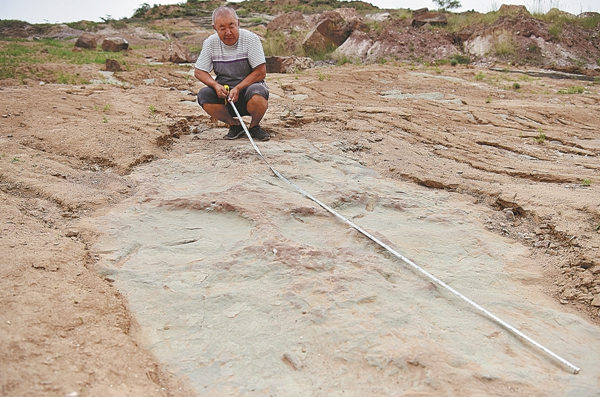Dinosaur footprints discovered in Hebei
 0 Comment(s)
0 Comment(s) Print
Print E-mail China Daily, August 3, 2022
E-mail China Daily, August 3, 2022

More than 4,300 dinosaur footprints have been discovered in Zhangjiakou, North China's Hebei province, the most such markings found in one spot in the country, according to the Department of Natural Resources of Hebei, which recently disclosed related survey results.
From the footprints, scientists can determine how dinosaurs walked, calculate their length, weight and size, and even estimate their walking speed.
"The footprints not only reflect dinosaurs' living habits and behavior, but also explain the relationship between dinosaurs and their living environment at the time," said Xing Lida, a dinosaur expert from China University of Geosciences.
Li Jianjun, a researcher from the Beijing Museum of Natural History, echoed Xing.
"Dinosaur bones become fossils after their death, while dinosaur footprints are left from when they were alive, which provide wonderful insights into how dinosaurs lived. They can provide a lot of information about their behavior, as well as information on paleogeography and paleoenvironment. Therefore, dinosaur footprints play an irreplaceable role," Li said.
The site in Zhangjiakou has surpassed the record set at a site in Sichuan province that has over 900 dinosaur footprints.
The footprints in Zhangjiakou were found in April 2020 in an area of more than 9,000 square meters in the city's Xuanhua district, the largest area with dinosaur footprints found in the country, Li said.
The site has been covered up for protection after experts carried out three-dimensional imaging and cast molds of the footprints, according to Hebei's natural resources department.
"It can be inferred that the footprints belong to an era around the Jurassic and the Cretaceous, when there were large forests and water sources here," said Sun Xiao, a chief engineer at the Regional Geological Survey Institute affiliated with Hebei Bureau of Geology and Mineral Resources Exploration, quoted by Hebei Daily. Sun participated in the investigation and research of the footprints.
A large number of herbivorous sauropods and carnivorous theropods could have coexisted at the time, Sun added.
Pointing at a tridactyl footprint at the site that looks like a bird claw, Li said the sharp-looking footprints are mostly left by carnivorous dinosaurs. Their footprints are about 10 centimeters long. Among them, the largest is 37.5 cm in length.
"Based on this, we can infer that the dinosaur's body length was four to five meters, being at the top of the food chain at that time," Li said.
According to Sun, they have discovered dinosaur footprints of four different genera along more than 70 tracks at the site. The footprints are located on fine, pebbly sandstone that dates back 150 million years and was covered by thick volcanic ash, providing good conditions for the preservation of the footprints.
A great number of dinosaur fossils and footprints have been found in Hebei's Zhangjiakou and Chengde in recent years, indicating that the two places once saw frequent dinosaur activity hundreds of millions of years ago, Sun added.
"At present, our research on paleontological fossil resources including dinosaur footprints in the two places is underway," he said.






Go to Forum >>0 Comment(s)